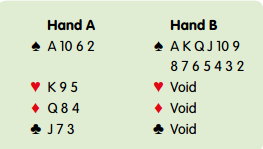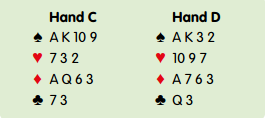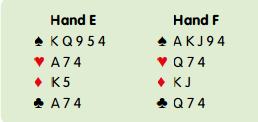Source: Mr. Bridge
Assessing a hand by counting four points for an ace, three for a king, two for a queen and one for a jack should be the start of how you look at it rather than the end. If you were buying a car, you might start by looking at the purchase price. However, you would not expect that alone to tell you whether to buy it. Likewise, the Milton 4321 count is merely one way of looking at a hand. Let us start with an extreme example.

Both hands have 10 points. Moreover, both hands have the same spot cards (we will come back to intermediate cards later). Hand A is a poor 10-point hand, with honours all over the place and an unproductive shape (4333). With Hand A, you might expect to make only a couple of tricks if partner has very little. Hand B is an incredible 10-point hand. What is more, no matter how many points you usually add for length or for shortages, no point count method is going to tell you that the hand will produce a grand slam. Now some more mundane cases:

Hand C and Hand D both have 13 points. Hand C is better than Hand D on two counts. First, the 10-9 combination is more useful in conjunction with other honours (as it is in the spade suit in Hand C) than it is on its own (in hearts in Hand D). Secondly, the doubleton queen is of unproven value. If partner has a collection of low clubs, Q-x may be worth no more than x-x. For offensive purposes, honours are better in long suits and together.
Suppose that you have opened 1NT, replied 2 to Stayman and seen partner raise to 3
to Stayman and seen partner raise to 3 . With Hand C, you would advance to 4
. With Hand C, you would advance to 4 . With Hand D, you would probably pass. Although other valuation methods would differentiate the hands, if you simply deduct a point for the unguarded queen, that would be a simple adjustment to make. So far, we have looked at just your hand. In reality, bridge is a partnership game. How two hands fit together makes a big difference.
. With Hand D, you would probably pass. Although other valuation methods would differentiate the hands, if you simply deduct a point for the unguarded queen, that would be a simple adjustment to make. So far, we have looked at just your hand. In reality, bridge is a partnership game. How two hands fit together makes a big difference.

Suppose partner opens 1 , you respond 1
, you respond 1 and partner raises to 2
and partner raises to 2 . If you simply count points, you will value the two hands as the same and make the same bid. In fact, you need to treat Hand F the same way you would if one or both of your queens were doubleton. Partner, with most likely five diamonds and four spades, may well have a doubleton heart or a doubleton club, perhaps both. A queen facing a doubleton is a duplicated or wasted value. In both hands, the king of diamonds is a great card, solidifying partner’s suit, so worth counting as an ace.
. If you simply count points, you will value the two hands as the same and make the same bid. In fact, you need to treat Hand F the same way you would if one or both of your queens were doubleton. Partner, with most likely five diamonds and four spades, may well have a doubleton heart or a doubleton club, perhaps both. A queen facing a doubleton is a duplicated or wasted value. In both hands, the king of diamonds is a great card, solidifying partner’s suit, so worth counting as an ace.
Another form of duplication occurs when you and your partner are short in the same suit. If you each have a doubleton club and each count a point for the doubleton, you will overvalue the combined trick-taking potential.

Suppose you open 1 , the next hand overcalls 2
, the next hand overcalls 2 , partner raises to 2
, partner raises to 2 and the next hand bids 3
and the next hand bids 3 . With Hand G, you should count points for your length or shortages (but not both) in the way you usually do. You should jump to 4
. With Hand G, you should count points for your length or shortages (but not both) in the way you usually do. You should jump to 4 . With Hand H, you should anticipate that partner probably has a doubleton club as well and content yourself with a game try.
. With Hand H, you should anticipate that partner probably has a doubleton club as well and content yourself with a game try.
Finally, possibly the easiest adjustment to make is for intermediate cards. The average hand contains one ten and one nine. If you have no tens or nines, deduct a point. If you have a couple of both tens and nines, add a point.
[box]
In Summary:
1 Point count may fail on freak hands.
2 Honours in long suits are worth more than those in short suits, especially if the honours in short suits are unguarded. Deduct a point for a doubleton queen or singleton king, but consider adding a point if your long suits are strong.
3 Beware of counting lower honours (queens and jacks) at full value in suits where you know partner is short, but give extra value to high cards that fill in partner’s long suits.
4 If your hand contains a couple fewer or a couple more than its share of tens and nines, subtract or add a point respectively.
[/box]
Esta entrada también está disponible en: Spanish

